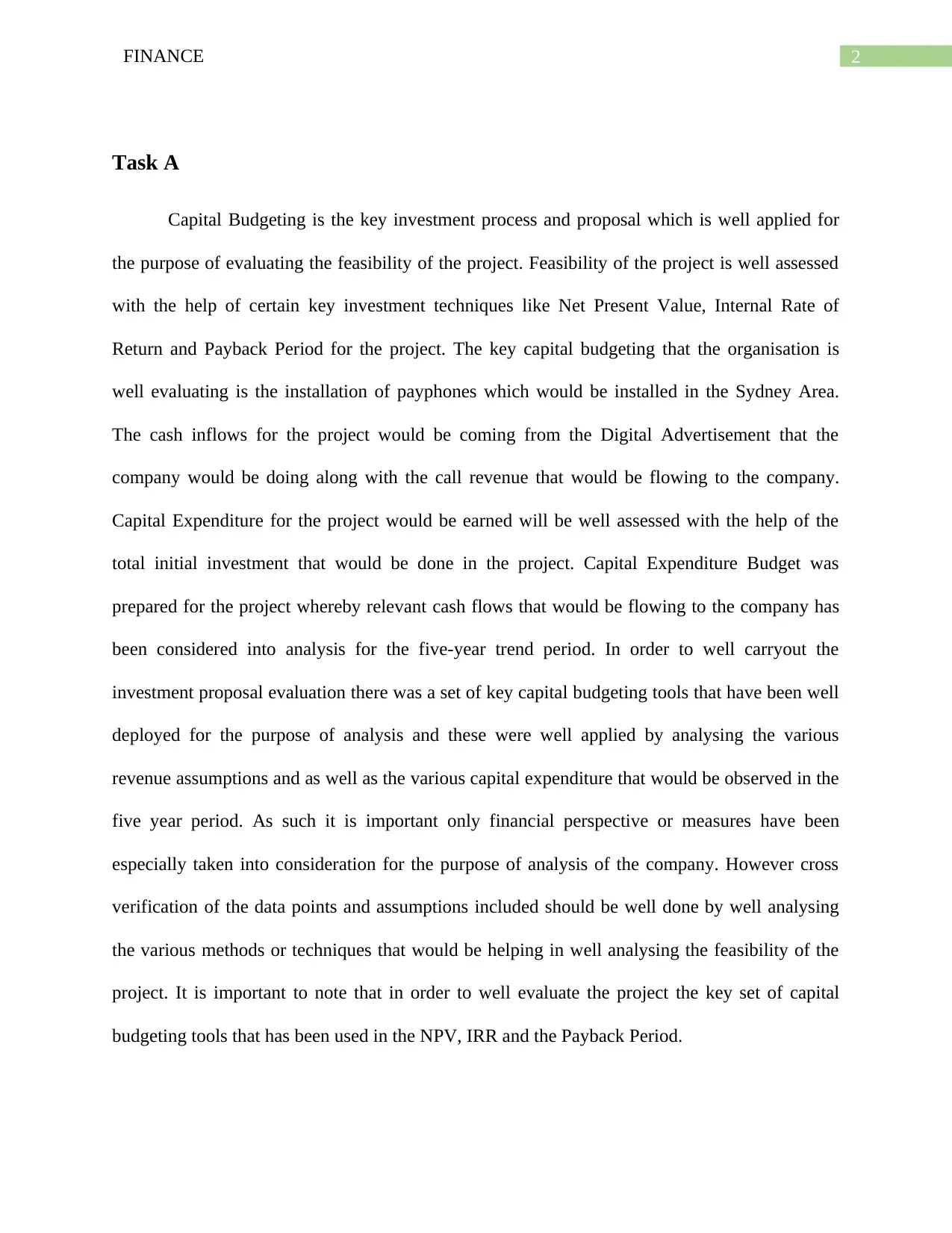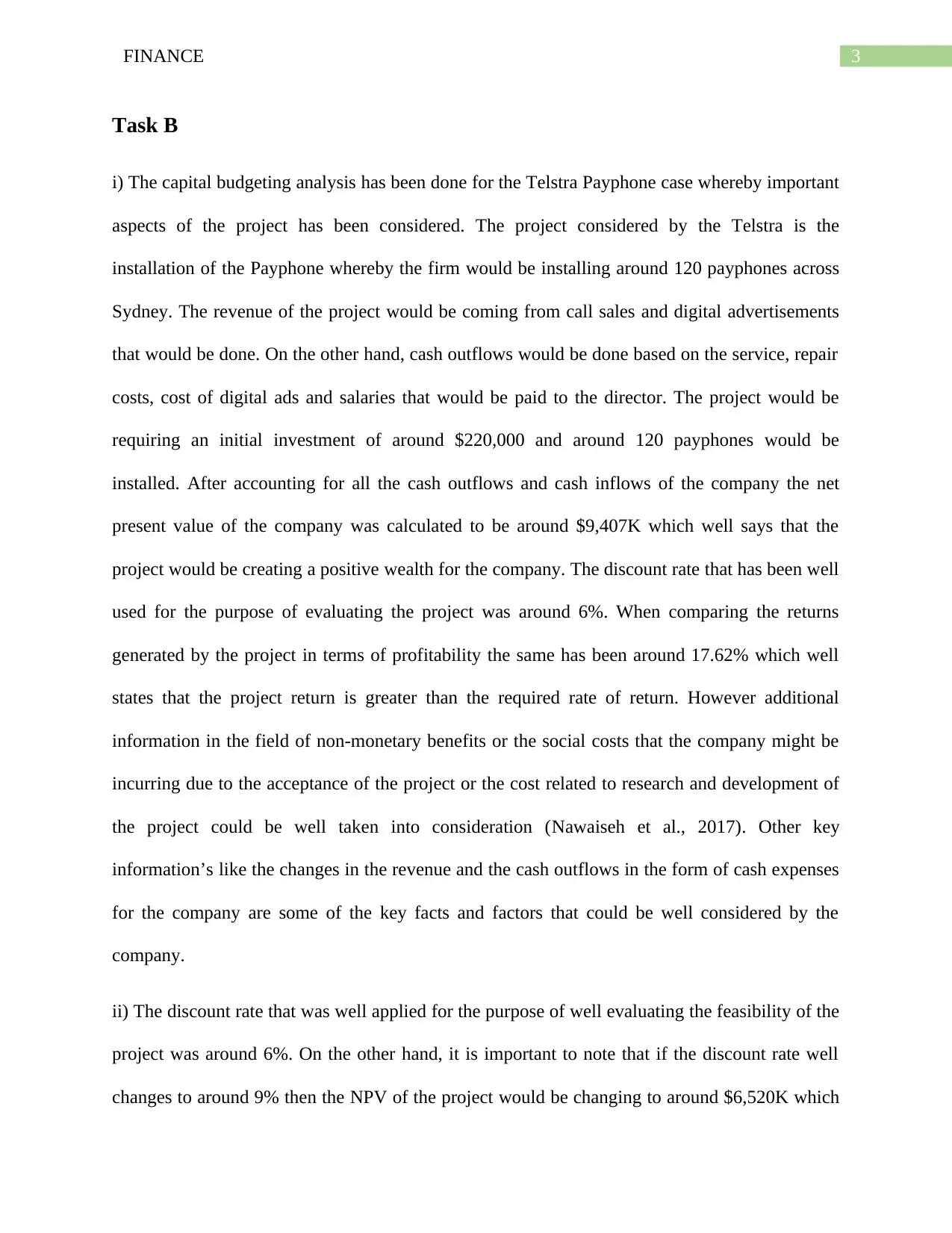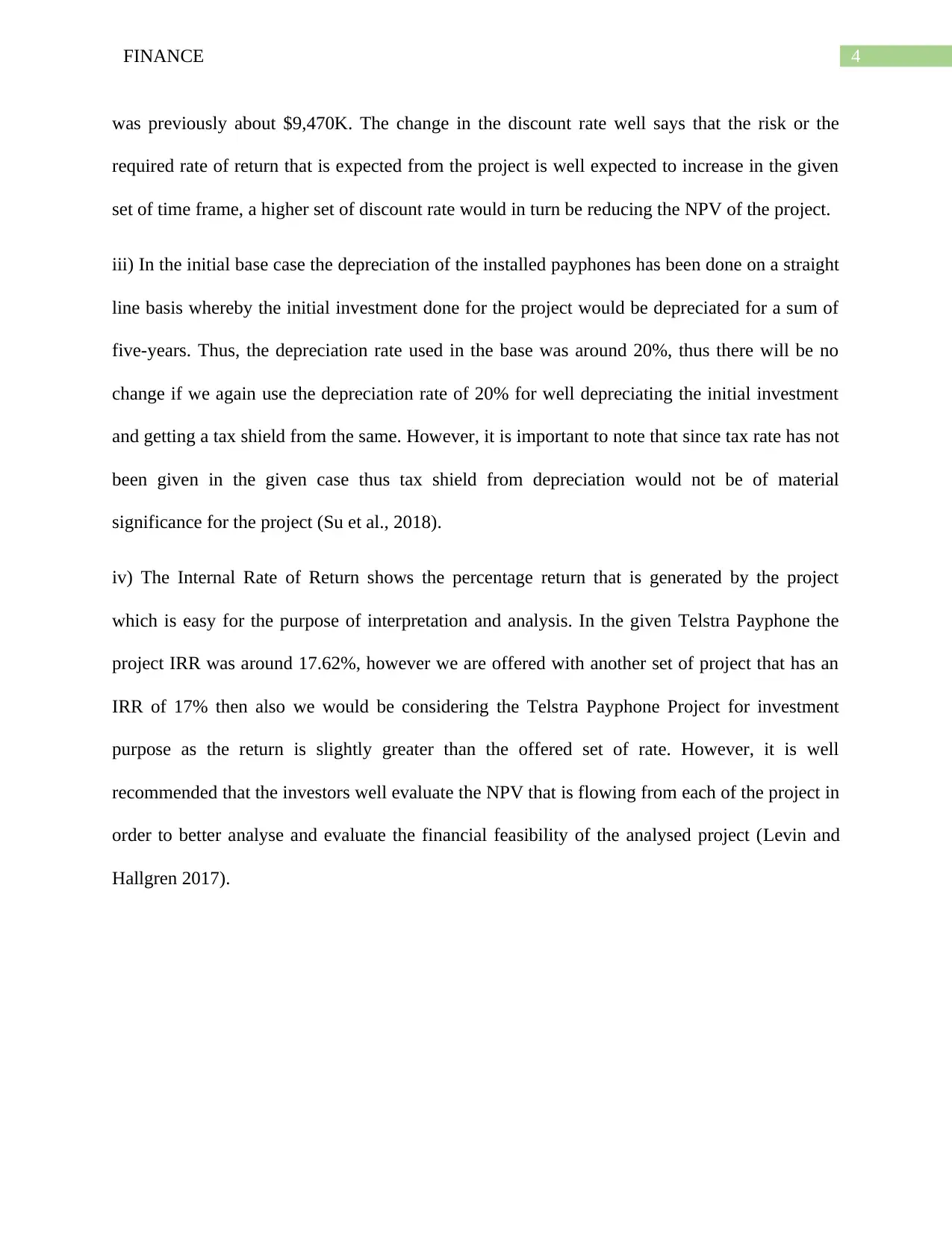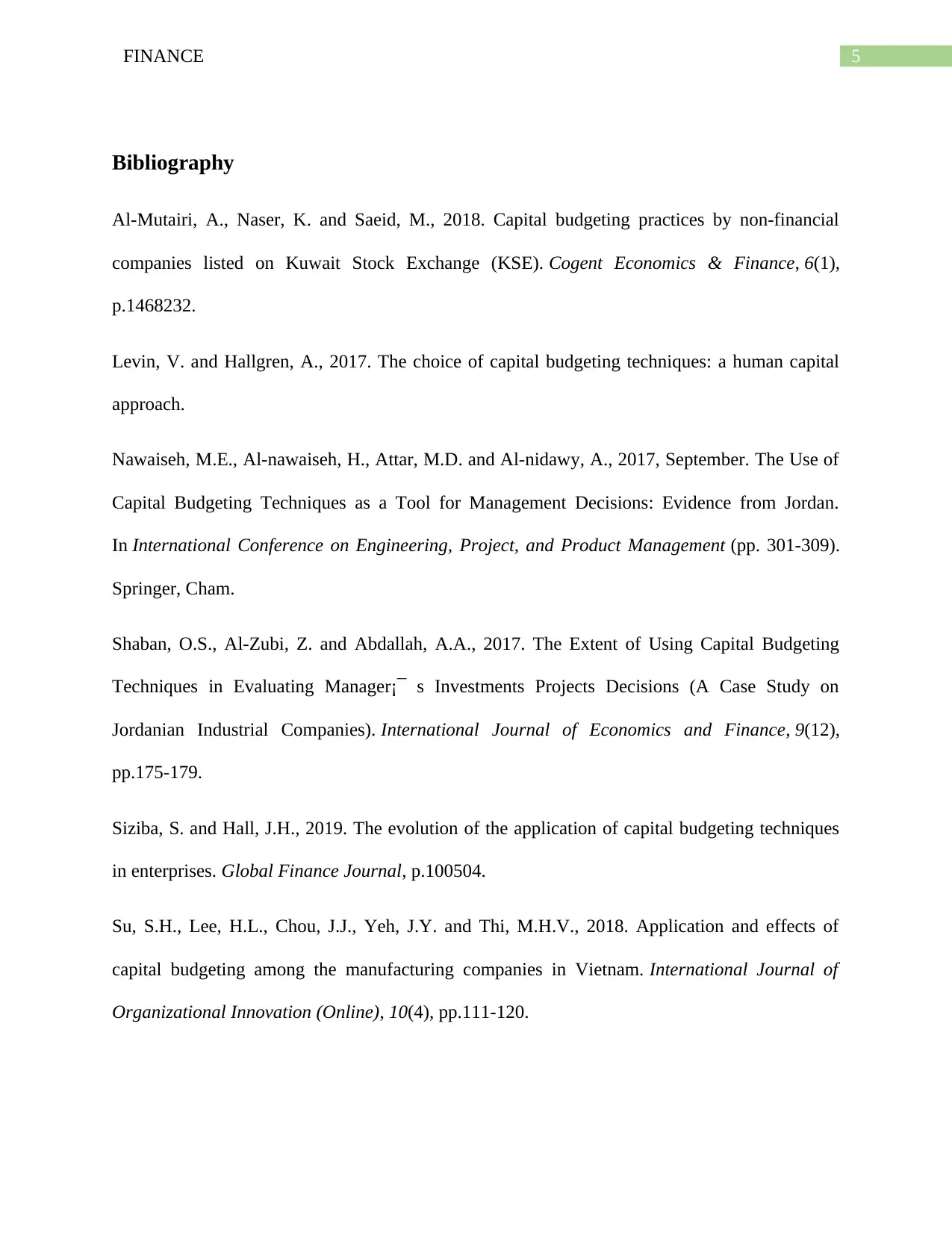University Finance Report: Telstra Payphone Investment Evaluation
VerifiedAdded on 2022/08/17
|6
|1291
|48
Report
AI Summary
This report analyzes a finance assignment focusing on capital budgeting and investment evaluation. It examines the Telstra Payphone project, assessing its financial feasibility using key techniques such as Net Present Value (NPV), Internal Rate of Return (IRR), and Payback Period. The analysis includes detailed consideration of cash inflows from digital advertising and call revenue, along with capital expenditures. The report calculates the NPV of the project, considering a discount rate of 6%, and assesses the project's profitability. It also explores the impact of changes in the discount rate, depreciation, and the comparison of IRR with other projects. The assignment highlights the importance of both financial and non-financial factors in investment decisions, providing a comprehensive overview of capital budgeting principles and their application in a real-world scenario.

Running head: FINANCE
Finance
Name of the Student:
Name of the University:
Author’s Note:
Finance
Name of the Student:
Name of the University:
Author’s Note:
Paraphrase This Document
Need a fresh take? Get an instant paraphrase of this document with our AI Paraphraser

1FINANCE
Table of Contents
Task A..............................................................................................................................................2
Task B..............................................................................................................................................3
Bibliography....................................................................................................................................5
Table of Contents
Task A..............................................................................................................................................2
Task B..............................................................................................................................................3
Bibliography....................................................................................................................................5

2FINANCE
Task A
Capital Budgeting is the key investment process and proposal which is well applied for
the purpose of evaluating the feasibility of the project. Feasibility of the project is well assessed
with the help of certain key investment techniques like Net Present Value, Internal Rate of
Return and Payback Period for the project. The key capital budgeting that the organisation is
well evaluating is the installation of payphones which would be installed in the Sydney Area.
The cash inflows for the project would be coming from the Digital Advertisement that the
company would be doing along with the call revenue that would be flowing to the company.
Capital Expenditure for the project would be earned will be well assessed with the help of the
total initial investment that would be done in the project. Capital Expenditure Budget was
prepared for the project whereby relevant cash flows that would be flowing to the company has
been considered into analysis for the five-year trend period. In order to well carryout the
investment proposal evaluation there was a set of key capital budgeting tools that have been well
deployed for the purpose of analysis and these were well applied by analysing the various
revenue assumptions and as well as the various capital expenditure that would be observed in the
five year period. As such it is important only financial perspective or measures have been
especially taken into consideration for the purpose of analysis of the company. However cross
verification of the data points and assumptions included should be well done by well analysing
the various methods or techniques that would be helping in well analysing the feasibility of the
project. It is important to note that in order to well evaluate the project the key set of capital
budgeting tools that has been used in the NPV, IRR and the Payback Period.
Task A
Capital Budgeting is the key investment process and proposal which is well applied for
the purpose of evaluating the feasibility of the project. Feasibility of the project is well assessed
with the help of certain key investment techniques like Net Present Value, Internal Rate of
Return and Payback Period for the project. The key capital budgeting that the organisation is
well evaluating is the installation of payphones which would be installed in the Sydney Area.
The cash inflows for the project would be coming from the Digital Advertisement that the
company would be doing along with the call revenue that would be flowing to the company.
Capital Expenditure for the project would be earned will be well assessed with the help of the
total initial investment that would be done in the project. Capital Expenditure Budget was
prepared for the project whereby relevant cash flows that would be flowing to the company has
been considered into analysis for the five-year trend period. In order to well carryout the
investment proposal evaluation there was a set of key capital budgeting tools that have been well
deployed for the purpose of analysis and these were well applied by analysing the various
revenue assumptions and as well as the various capital expenditure that would be observed in the
five year period. As such it is important only financial perspective or measures have been
especially taken into consideration for the purpose of analysis of the company. However cross
verification of the data points and assumptions included should be well done by well analysing
the various methods or techniques that would be helping in well analysing the feasibility of the
project. It is important to note that in order to well evaluate the project the key set of capital
budgeting tools that has been used in the NPV, IRR and the Payback Period.
⊘ This is a preview!⊘
Do you want full access?
Subscribe today to unlock all pages.

Trusted by 1+ million students worldwide

3FINANCE
Task B
i) The capital budgeting analysis has been done for the Telstra Payphone case whereby important
aspects of the project has been considered. The project considered by the Telstra is the
installation of the Payphone whereby the firm would be installing around 120 payphones across
Sydney. The revenue of the project would be coming from call sales and digital advertisements
that would be done. On the other hand, cash outflows would be done based on the service, repair
costs, cost of digital ads and salaries that would be paid to the director. The project would be
requiring an initial investment of around $220,000 and around 120 payphones would be
installed. After accounting for all the cash outflows and cash inflows of the company the net
present value of the company was calculated to be around $9,407K which well says that the
project would be creating a positive wealth for the company. The discount rate that has been well
used for the purpose of evaluating the project was around 6%. When comparing the returns
generated by the project in terms of profitability the same has been around 17.62% which well
states that the project return is greater than the required rate of return. However additional
information in the field of non-monetary benefits or the social costs that the company might be
incurring due to the acceptance of the project or the cost related to research and development of
the project could be well taken into consideration (Nawaiseh et al., 2017). Other key
information’s like the changes in the revenue and the cash outflows in the form of cash expenses
for the company are some of the key facts and factors that could be well considered by the
company.
ii) The discount rate that was well applied for the purpose of well evaluating the feasibility of the
project was around 6%. On the other hand, it is important to note that if the discount rate well
changes to around 9% then the NPV of the project would be changing to around $6,520K which
Task B
i) The capital budgeting analysis has been done for the Telstra Payphone case whereby important
aspects of the project has been considered. The project considered by the Telstra is the
installation of the Payphone whereby the firm would be installing around 120 payphones across
Sydney. The revenue of the project would be coming from call sales and digital advertisements
that would be done. On the other hand, cash outflows would be done based on the service, repair
costs, cost of digital ads and salaries that would be paid to the director. The project would be
requiring an initial investment of around $220,000 and around 120 payphones would be
installed. After accounting for all the cash outflows and cash inflows of the company the net
present value of the company was calculated to be around $9,407K which well says that the
project would be creating a positive wealth for the company. The discount rate that has been well
used for the purpose of evaluating the project was around 6%. When comparing the returns
generated by the project in terms of profitability the same has been around 17.62% which well
states that the project return is greater than the required rate of return. However additional
information in the field of non-monetary benefits or the social costs that the company might be
incurring due to the acceptance of the project or the cost related to research and development of
the project could be well taken into consideration (Nawaiseh et al., 2017). Other key
information’s like the changes in the revenue and the cash outflows in the form of cash expenses
for the company are some of the key facts and factors that could be well considered by the
company.
ii) The discount rate that was well applied for the purpose of well evaluating the feasibility of the
project was around 6%. On the other hand, it is important to note that if the discount rate well
changes to around 9% then the NPV of the project would be changing to around $6,520K which
Paraphrase This Document
Need a fresh take? Get an instant paraphrase of this document with our AI Paraphraser

4FINANCE
was previously about $9,470K. The change in the discount rate well says that the risk or the
required rate of return that is expected from the project is well expected to increase in the given
set of time frame, a higher set of discount rate would in turn be reducing the NPV of the project.
iii) In the initial base case the depreciation of the installed payphones has been done on a straight
line basis whereby the initial investment done for the project would be depreciated for a sum of
five-years. Thus, the depreciation rate used in the base was around 20%, thus there will be no
change if we again use the depreciation rate of 20% for well depreciating the initial investment
and getting a tax shield from the same. However, it is important to note that since tax rate has not
been given in the given case thus tax shield from depreciation would not be of material
significance for the project (Su et al., 2018).
iv) The Internal Rate of Return shows the percentage return that is generated by the project
which is easy for the purpose of interpretation and analysis. In the given Telstra Payphone the
project IRR was around 17.62%, however we are offered with another set of project that has an
IRR of 17% then also we would be considering the Telstra Payphone Project for investment
purpose as the return is slightly greater than the offered set of rate. However, it is well
recommended that the investors well evaluate the NPV that is flowing from each of the project in
order to better analyse and evaluate the financial feasibility of the analysed project (Levin and
Hallgren 2017).
was previously about $9,470K. The change in the discount rate well says that the risk or the
required rate of return that is expected from the project is well expected to increase in the given
set of time frame, a higher set of discount rate would in turn be reducing the NPV of the project.
iii) In the initial base case the depreciation of the installed payphones has been done on a straight
line basis whereby the initial investment done for the project would be depreciated for a sum of
five-years. Thus, the depreciation rate used in the base was around 20%, thus there will be no
change if we again use the depreciation rate of 20% for well depreciating the initial investment
and getting a tax shield from the same. However, it is important to note that since tax rate has not
been given in the given case thus tax shield from depreciation would not be of material
significance for the project (Su et al., 2018).
iv) The Internal Rate of Return shows the percentage return that is generated by the project
which is easy for the purpose of interpretation and analysis. In the given Telstra Payphone the
project IRR was around 17.62%, however we are offered with another set of project that has an
IRR of 17% then also we would be considering the Telstra Payphone Project for investment
purpose as the return is slightly greater than the offered set of rate. However, it is well
recommended that the investors well evaluate the NPV that is flowing from each of the project in
order to better analyse and evaluate the financial feasibility of the analysed project (Levin and
Hallgren 2017).

5FINANCE
Bibliography
Al-Mutairi, A., Naser, K. and Saeid, M., 2018. Capital budgeting practices by non-financial
companies listed on Kuwait Stock Exchange (KSE). Cogent Economics & Finance, 6(1),
p.1468232.
Levin, V. and Hallgren, A., 2017. The choice of capital budgeting techniques: a human capital
approach.
Nawaiseh, M.E., Al-nawaiseh, H., Attar, M.D. and Al-nidawy, A., 2017, September. The Use of
Capital Budgeting Techniques as a Tool for Management Decisions: Evidence from Jordan.
In International Conference on Engineering, Project, and Product Management (pp. 301-309).
Springer, Cham.
Shaban, O.S., Al-Zubi, Z. and Abdallah, A.A., 2017. The Extent of Using Capital Budgeting
Techniques in Evaluating Manager¡¯ s Investments Projects Decisions (A Case Study on
Jordanian Industrial Companies). International Journal of Economics and Finance, 9(12),
pp.175-179.
Siziba, S. and Hall, J.H., 2019. The evolution of the application of capital budgeting techniques
in enterprises. Global Finance Journal, p.100504.
Su, S.H., Lee, H.L., Chou, J.J., Yeh, J.Y. and Thi, M.H.V., 2018. Application and effects of
capital budgeting among the manufacturing companies in Vietnam. International Journal of
Organizational Innovation (Online), 10(4), pp.111-120.
Bibliography
Al-Mutairi, A., Naser, K. and Saeid, M., 2018. Capital budgeting practices by non-financial
companies listed on Kuwait Stock Exchange (KSE). Cogent Economics & Finance, 6(1),
p.1468232.
Levin, V. and Hallgren, A., 2017. The choice of capital budgeting techniques: a human capital
approach.
Nawaiseh, M.E., Al-nawaiseh, H., Attar, M.D. and Al-nidawy, A., 2017, September. The Use of
Capital Budgeting Techniques as a Tool for Management Decisions: Evidence from Jordan.
In International Conference on Engineering, Project, and Product Management (pp. 301-309).
Springer, Cham.
Shaban, O.S., Al-Zubi, Z. and Abdallah, A.A., 2017. The Extent of Using Capital Budgeting
Techniques in Evaluating Manager¡¯ s Investments Projects Decisions (A Case Study on
Jordanian Industrial Companies). International Journal of Economics and Finance, 9(12),
pp.175-179.
Siziba, S. and Hall, J.H., 2019. The evolution of the application of capital budgeting techniques
in enterprises. Global Finance Journal, p.100504.
Su, S.H., Lee, H.L., Chou, J.J., Yeh, J.Y. and Thi, M.H.V., 2018. Application and effects of
capital budgeting among the manufacturing companies in Vietnam. International Journal of
Organizational Innovation (Online), 10(4), pp.111-120.
⊘ This is a preview!⊘
Do you want full access?
Subscribe today to unlock all pages.

Trusted by 1+ million students worldwide
1 out of 6
Related Documents
Your All-in-One AI-Powered Toolkit for Academic Success.
+13062052269
info@desklib.com
Available 24*7 on WhatsApp / Email
![[object Object]](/_next/static/media/star-bottom.7253800d.svg)
Unlock your academic potential
Copyright © 2020–2025 A2Z Services. All Rights Reserved. Developed and managed by ZUCOL.





